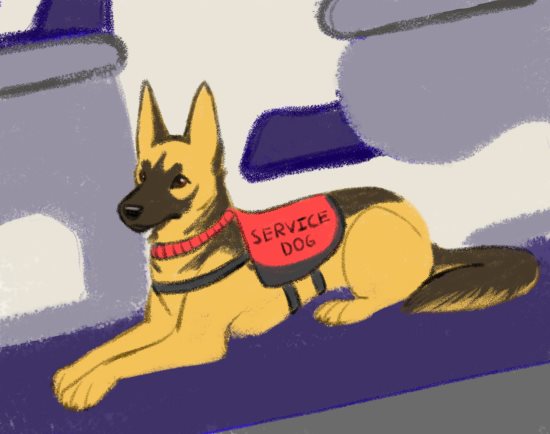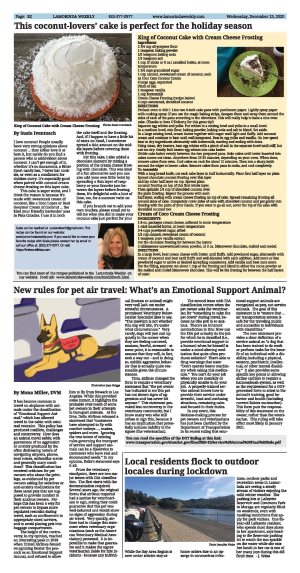| | Published December 23rd, 2020
| New rules for pet air travel: What's an Emotional Support Animal?
| | | By Mona Miller, DVM |  | | Illustration Jaya Griggs |
It has become common to travel on airplanes with animals under the classification of "Emotional Support Animal," which has allowed travel in the cabin with minimal restraint. This policy has produced conflicts, challenges and controversy. How does an animal travel safely, with guarantees of no aggression or anxiety produced by the often distressing nature of navigating airports, planes, loud noises, unfamiliar scents and generally scary conditions? This classification has received criticism for pet owners who abuse the privilege, as evidenced by pet owners asking for sedatives or anti-anxiety medications for these same pets that are supposed to provide comfort to their anxious owners. Perhaps this has been a way for pet owners to bypass more regulated restraint during travel, such as confinement to appropriate-sized carriers, and to avoid placing pets into baggage compartments.
 The height of the controversy, in my opinion, reached an interesting peak in 2018 when United Airlines denied recognizing Dexter the peacock as an Emotional Support Animal, and refused to allow him to fly from Newark to Los Angeles. While this provided some humor, it highlights the probable over-reach of some pet owners in their attempts to transport animals. At the time, Delta Airlines released a statement that "customers have attempted to fly with comfort turkeys ., snakes, spiders and more. Ignoring the true intent of existing rules governing the transport of service and support animals can be a disservice to customers who have real and documented needs." In my opinion, Delta's statement says it all.
The height of the controversy, in my opinion, reached an interesting peak in 2018 when United Airlines denied recognizing Dexter the peacock as an Emotional Support Animal, and refused to allow him to fly from Newark to Los Angeles. While this provided some humor, it highlights the probable over-reach of some pet owners in their attempts to transport animals. At the time, Delta Airlines released a statement that "customers have attempted to fly with comfort turkeys ., snakes, spiders and more. Ignoring the true intent of existing rules governing the transport of service and support animals can be a disservice to customers who have real and documented needs." In my opinion, Delta's statement says it all.
 From the veterinary standpoint, there are two major issues with ESA classification. The first starts with the documentation required. Several years ago, the original forms that airlines required had a section for veterinarians to sign, stating they could guarantee that this pet was well-behaved and would show no signs of aggression during air travel. Very quickly, airlines had to change this statement when veterinary organizations (such as the American Veterinary Medical Association) protested. It is impossible to make that guarantee and it makes the signee veterinarian liable for bite incidents - because any individual (human or animal) might very well lash out under stressful circumstances. A prominent Veterinary Behavioralist Specialist likes to say, "The question is not whether this dog will bite, it's under what circumstances." Very rarely, dogs will just curl up quietly in the corner when they are feeling cornered, anxious, fearful, stressed - at some point, it is reasonable to assume that they will, in fact, seek a way out - and in doing so, exhibit aggression behavior that is actually quite reasonable given the circumstances.
From the veterinary standpoint, there are two major issues with ESA classification. The first starts with the documentation required. Several years ago, the original forms that airlines required had a section for veterinarians to sign, stating they could guarantee that this pet was well-behaved and would show no signs of aggression during air travel. Very quickly, airlines had to change this statement when veterinary organizations (such as the American Veterinary Medical Association) protested. It is impossible to make that guarantee and it makes the signee veterinarian liable for bite incidents - because any individual (human or animal) might very well lash out under stressful circumstances. A prominent Veterinary Behavioralist Specialist likes to say, "The question is not whether this dog will bite, it's under what circumstances." Very rarely, dogs will just curl up quietly in the corner when they are feeling cornered, anxious, fearful, stressed - at some point, it is reasonable to assume that they will, in fact, seek a way out - and in doing so, exhibit aggression behavior that is actually quite reasonable given the circumstances.
 Thus, airlines changed the form to require a veterinary statement that "the pet owner has indicated to me this pet has not shown signs of aggression and has never bit anyone." This statement provoked less controversy in the veterinary community, but I know many vets who still refuse to sign this, because it has an implication that potentially induces liability to the signee (the veterinarian).
Thus, airlines changed the form to require a veterinary statement that "the pet owner has indicated to me this pet has not shown signs of aggression and has never bit anyone." This statement provoked less controversy in the veterinary community, but I know many vets who still refuse to sign this, because it has an implication that potentially induces liability to the signee (the veterinarian).
 The second issue with ESA classification occurs when the pet owner asks the veterinarian for "something to calm the pet down" during travel, because he (the pet) is so anxious. There's an inherent contradiction in this: How can the ESA pet actually do the job for which he is classified (i.e., provide emotional support to a human) when he himself is under a mind-altering medication that quite often produces sedation? That's akin to drug warnings that state: "Don't operate heavy machinery when taking this medication." You can't do your job when you are mentally or physically unable to do your job. A properly-trained service animal knows how to provide their service under stressful, loud and confusing situations, remaining calm and focused in their duties.
The second issue with ESA classification occurs when the pet owner asks the veterinarian for "something to calm the pet down" during travel, because he (the pet) is so anxious. There's an inherent contradiction in this: How can the ESA pet actually do the job for which he is classified (i.e., provide emotional support to a human) when he himself is under a mind-altering medication that quite often produces sedation? That's akin to drug warnings that state: "Don't operate heavy machinery when taking this medication." You can't do your job when you are mentally or physically unable to do your job. A properly-trained service animal knows how to provide their service under stressful, loud and confusing situations, remaining calm and focused in their duties.
 In any event, this decision-making process for pet owners and veterinarians has just been clarified by the Department of Transportation in its recent ruling that emotional support animals are recognized as pets, not service animals. The goal of this statement is to "ensure that . air transportation system is safe for the traveling public and accessible to individuals with disabilities."
In any event, this decision-making process for pet owners and veterinarians has just been clarified by the Department of Transportation in its recent ruling that emotional support animals are recognized as pets, not service animals. The goal of this statement is to "ensure that . air transportation system is safe for the traveling public and accessible to individuals with disabilities."
 The new statement provides a clear definition of a service animal as "a dog that has been trained to do work or perform tasks for the benefit of an individual with a disability, including a physical, sensory, psychiatric, intellectual, or other mental disability." It also provides some specific key points in allowing airline carriers to require a harness/leash system, as well as the requirement for a DOT-generated form to attest to the animal's training, good behavior and health (including current Rabies vaccination). This form puts the responsibility of this statement on the owner, rather than the veterinarian. This ruling will take effect most likely in January 2021.
The new statement provides a clear definition of a service animal as "a dog that has been trained to do work or perform tasks for the benefit of an individual with a disability, including a physical, sensory, psychiatric, intellectual, or other mental disability." It also provides some specific key points in allowing airline carriers to require a harness/leash system, as well as the requirement for a DOT-generated form to attest to the animal's training, good behavior and health (including current Rabies vaccination). This form puts the responsibility of this statement on the owner, rather than the veterinarian. This ruling will take effect most likely in January 2021.
 You can read the specifics of the DOT Ruling at this link:
You can read the specifics of the DOT Ruling at this link:
 www.transportation.gov/sites/dot.gov/files/2020-12/Service%20Animal%20Final%20Rule.pdf
www.transportation.gov/sites/dot.gov/files/2020-12/Service%20Animal%20Final%20Rule.pdf |
 | | Dr. Mona Miller lives in Lafayette with her son, two cats and yellow Labrador. She attended UC Berkeley as an undergraduate, and received her DVM from UC Davis. She has been happy to call Lafayette home since 2001. She can be reached via email at MonaSDVM@aol.com. She welcomes questions from readers that may get incorporated into a column. | | | | | | | | | | | |




